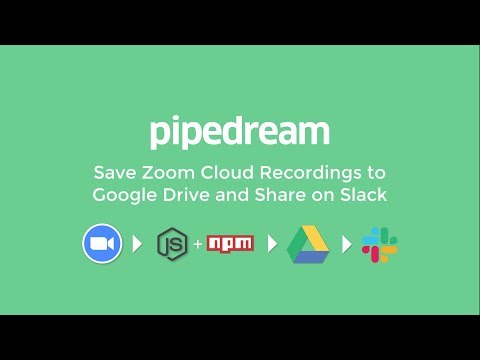What do you want to automate
with Zoom and Snowflake?
Prompt, edit and deploy AI agents that connect to Zoom, Snowflake and 3,000+ other apps in seconds.
Trusted by 1,000,000+ developers from startups to Fortune 500 companies
Popular Zoom and Snowflake Triggers#
Emit new event each time a meeting is created where you're the host
Emit new event each time a meeting starts where you're the host
Run a SQL query on a schedule, triggering a workflow for each row of results
Emit new event each time a new recording completes for a meeting or webinar where you're the host
Overview of Zoom#
The Zoom API lets you tap into a rich set of functionalities to enhance the video conferencing experience within your own app or workflow. With the Zoom API on Pipedream, you can automatically create meetings, manage users, send meeting notifications, and more, orchestrating these actions within a broader automation. This allows for seamless integration with other services, enabling both data collection and action triggers based on Zoom events.
Pipedream workflows allow you to run any Node.js code that connects to the Zoom API. Just create a new workflow, then add prebuilt Zoom actions (create a meeting, send a chat message, etc.) or write your own code. These workflows can be triggered by HTTP requests, timers, email, or on any app-based event (new tweets, a GitHub PR, Zoom events, etc).
Connect Zoom#
import { axios } from "@pipedream/platform"
export default defineComponent({
props: {
zoom: {
type: "app",
app: "zoom",
}
},
async run({steps, $}) {
return await axios($, {
url: `https://api.zoom.us/v2/users/me`,
headers: {
Authorization: `Bearer ${this.zoom.$auth.oauth_access_token}`,
},
})
},
})
Overview of Snowflake#
Snowflake offers a cloud database and related tools to help developers create robust, secure, and scalable data warehouses. See Snowflake's Key Concepts & Architecture
Getting Started
1. Create a user, role and warehouse in Snowflake
Snowflake recommends you create a new user, role, and warehouse when you integrate a third-party tool like Pipedream. This way, you can control permissions via the user / role, and separate Pipedream compute and costs with the warehouse. You can do this directly in the Snowflake UI
We recommend you create a read-only account if you only need to query Snowflake. If you need to insert data into Snowflake, add permissions on the appropriate objects after you create your user.
2. Enter those details in Pipedream
Visit https://pipedream.com/accounts. Click the button to Connect an App. Enter the required Snowflake account data.
You'll only need to connect your account once in Pipedream. You can connect this account to multiple workflows to run queries against Snowflake, insert data, and more.
3. Build your first workflow
Visit https://pipedream.com/new to build your first workflow. Pipedream workflows let you connect Snowflake with 3,000+ other apps. You can trigger workflows on Snowflake queries, sending results to Slack, Google Sheets, or any app that exposes an API. Or you can accept data from another app, transform it with Python, Node.js, Go or Bash code, and insert it into Snowflake.
Learn more at Pipedream University
Connect Snowflake#
import snowflake from '@pipedream/snowflake';
export default defineComponent({
props: {
snowflake,
},
async run({ $ }) {
// Component source code:
// https://github.com/PipedreamHQ/pipedream/tree/master/components/snowflake
return this.snowflake.executeQuery({
sqlText: `SELECT CURRENT_IP_ADDRESS()`,
binds: [],
});
},
});Related Videos#
